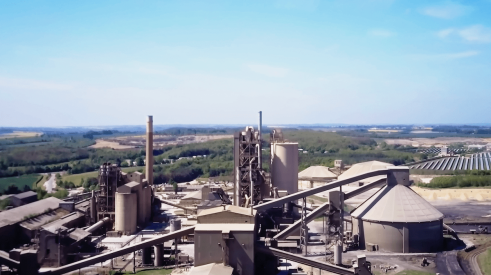| Chris Meinhart of Hart Builders is using CSST pipe in this 30,000-square-foot custom home in Willistown, Pa. The plywood columns eventually will be covered in stucco. The octagonal structure over Meinhart’s right shoulder houses a stairwell and an elevator. |
Custom builder Chris Meinhart, an 18-year veteran of the construction business, prides himself on his knowledge and use of cutting-edge building materials and finished products. While it might mean taking a step or two up in the material cost, the owner of Media, Pa.-based Hart Builders says the key in evaluating product is the total cost.
One product that made dollars and sense to Meinhart is flexible, corrugated stainless steel tubing (CSST) for gas supply. Introduced in the early 1990s and now code-approved in all 50 U.S. states, CSST’s share of the residential gas piping market has gained steadily in recent years. Foster-Miller Inc., the engineering company that helped launch the product in the United States, pegs CSST’s current share at 35% to 40%.
“With the pending approval of CSST by the Uniform Plumbing Code and its recent acceptance in the new California Plumbing Code, the final two barriers to the product’s growth are coming down,” says Bob Torbin, manager of business development at Foster-Miller. “A 50% to 60% share by 2005 is likely.”
Problem Defined
| Meinhart makes gas piping connections at the manifold in the Willistown home. Each 3/4-inch line coming off the manifold leads to a different gas fireplace or appliance. |
Still, CSST remains a relatively new product for many home builders, especially in the custom category. Not so Meinhart. Spurred by a trade-magazine ad, he decided in 1994 to abandon traditional black iron pipe in favor of CSST.
Why the sudden switch from a proven performer? Meinhart explains that he likes to stay on the cutting edge in building materials and finished products, even if it means taking a step or two up in price. Given the tastes and budgets of his luxury home buyers, that sense of adventure frequently pays off.
But with an all-but-invisible, behind-the-walls product such as gas piping, Meinhart wasn’t looking to change simply for change’s sake.
“The hardest part of any gas-line installation job is sizing it properly and mapping out the pipe runs to all the various appliances,” he explains. “The homes I build are so big, I’ll have pipe runs extending up to 200 feet from the manifold. I need something to make these long runs easier to install in the larger, increasingly complex homes I build.”
Much of this challenge stems from the changing design and the increasing number of amenities in upscale homes. In addition, rising land costs have forced custom builders to build “up” rather than “out,” Meinhart notes. That creates “a lot more corners, angles and such that the gas piping must maneuver around to reach the growing number of gas appliances in a modern home.” The list includes not only cooking, space heating and domestic hot-water equipment, but also pool heaters and more than one gas fireplace.
“Everyone likes getting a flame with a flip of the switch,” Meinhart says. “These days I install a minimum of three fireplaces per home, with four or five being more common. In fact, it’s not unusual for me to run eight or nine gas lines in a home. In one project we have 10, and there may be more before we’re through.”
Another complication is the trend to finished basements with 9- and 10-foot-high ceilings. As a consequence, says Meinhart, “I don’t always have the room to run pipe under the joists. Nor can I use soffits to hide the pipe because most owners want flat ceilings.”
The upshot: It became increasingly difficult and expensive to lay out these systems with rigid pipe. Running up walls and down joists, a single black-iron gas line from manifold to appliance could need 10 fittings to accommodate all the twists and turns. With eight to 10 lines per home, Meinhart says, “All the cutting and threading necessary to make those connections got to be extremely time-consuming and expensive.”
Problem Eliminated
| A close-up of two 1/2-inch CSST lines connected to a manifold with X-R brass fittings |
CSST has virtually eliminated these installation challenges while slashing Meinhart’s installation time and overall costs for gas piping.
Made of 304 stainless steel encased in a protective yellow polyethylene jacket, the corrugated flexible tubing is manipulated easily by hand over, under or around any obstacle to a pipe run. Instead of 10 connections in a typical 100-foot line, Meinhart has two: one at the manifold in the mechanical room, the other at the appliance. A specially designed brass fitting, engineered specifically for the Gastite CSST system Meinhart uses, provides a secure, metal-to-metal seal, with no O-rings or gaskets. The only tools needed are a small tube cutter, a utility knife and a common wrench to tighten the fittings.
CSST addresses an important safety issue as well: leaky joints in the line. Obviously, fewer connections translate into fewer potential leaks. That means no more tracking down leaks during post-installation testing — running from one joint to the next, up and down a run. “You don’t get that many leaks with an iron-pipe installation during a pressure test,” says Meinhart. “But when the pressure drops, you must check every last fitting in the line. For a house with 70 or 80 fittings, that’s a lot of time — and cost.”
One-Man Gang
|
Labor savings and convenience are at the heart of Meinhart’s preference for CSST over black iron. Meinhart prefers to install the product by himself. Because Gastite is so lightweight — a 250-foot reel of half-inch tube weighs only 38 pounds — that’s easily done.
Working alone at a home in Edgemont, Pa., Meinhart needed only 16 man-hours to install eight lines, or 530 feet of CSST, using 1-inch tube for the pool and spa, three-quarter-inch to the four gas fireplaces (wider tubing for the longer runs) and half-inch tube everywhere else. Had he done the house in black iron, Meinhart says he would have needed two additional installers to help with the cutting and threading, with the trio requiring nearly three days to finish. He pegs the time at 22 hours total, or 66 man-hours — 50 more than what he needed with Gastite.
At a larger home in Willistown, Pa., Meinhart did recruit two plumber’s helpers to run the 1,500 feet needed for the 10 lines. Total installation time: 21/2 days, or 60 man-hours. With metal pipe, Meinhart projects the same three-man crew would have required six days, or 144 man-hours — a 240% increase.
The work was not exactly the same at each house. In Willistown, the basement is entirely devoted to utilities, so Meinhart hung long, straight runs of CSST from unistrut metal tracking that attached to the flat ceiling with a simple screw. “It went faster than you might have expected, given the size of the house,” he says. “I could run an entire appliance line in an hour.”
The smaller Edgemont home’s basement is finished, so the CSST lines had to be tucked away in the rafters. “Every 4 feet, we had to install a supporting bracket to fix the tube to the joists, which made the job a little more time-consuming,” Meinhart says.
No More Cutting Machine
|
Nonetheless, the labor savings in both cases were more than enough to offset the higher cost of CSST. (In fact, one of the most time-consuming aspects of any job is the few inches of metal piping Meinhart used to finish off every run at the appliance connection, as required by local codes.) The net savings, achieved job after job, is why Meinhart long ago sold all his pipe-cutting and -threading equipment. It’s not like he plans to go back to metal anytime soon. “This product is more expensive per foot than iron pipe,” says Meinhart, “but I save a lot more money in the long run on labor, whose costs are rising faster than product prices.”
Of course, by “labor,” Meinhart is referring to what’s done on the drawing boards as well as the job site.
“Unlike iron pipe, CSST spares me all those long hours of head-scratching design work, trying to map out how I’m going to run my gas pipe around all the obstacles and make it work with my finishes,” Meinhart says. “CSST makes it easy, and I never have a problem when I’m done.
Advertisement
Related Stories
Awards
6th Annual Most Valuable Product Awards
Drumroll ... Please join us in celebrating our 6th Annual MVP Awards winners, which represent the best in innovative building products
Sustainability
Fortera Takes Concrete Steps to Reduce the Climate Impact of Cement
Clean-tech company Fortera, which uses technology to capture carbon emissions form cement manufacturing, will open its first commercial-scale operation on April 12, 2024, in California
Building Materials
Lumber Leads Building Materials Prices Higher in March
Overall, the cost of building materials rose during March, with softwood lumber, gypsum products, and concrete all seeing price increases. Only steel mill materials saw price drops






